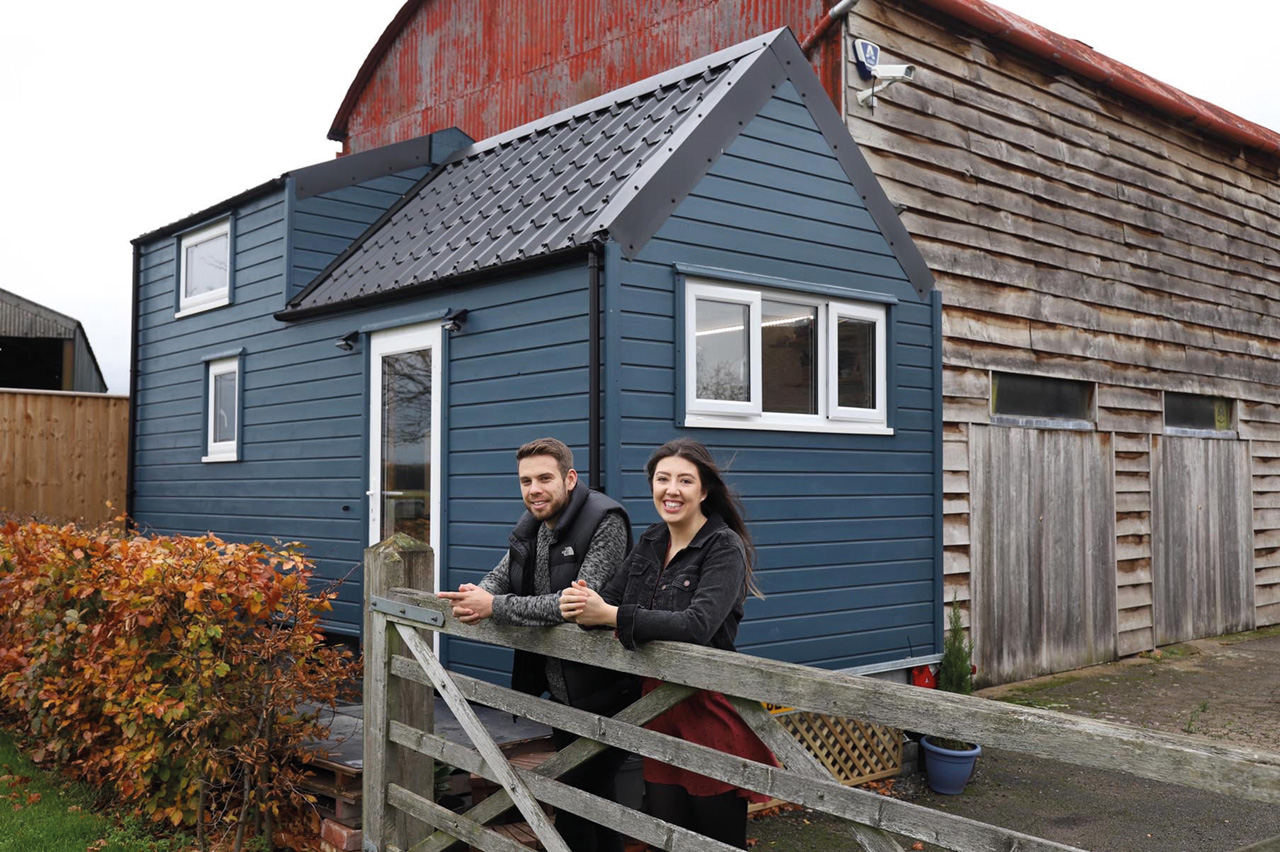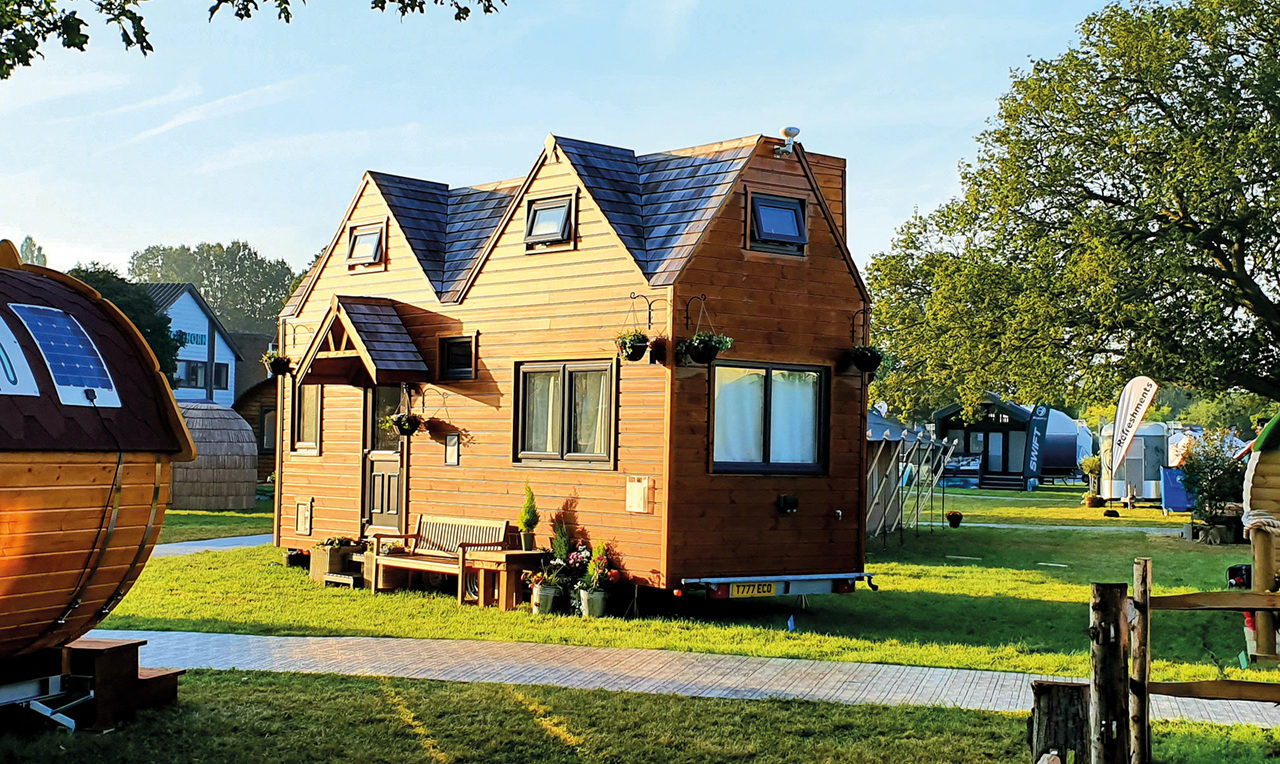Room for improvement
They’re cute and they’re popular on social media – but tiny houses could also play a role in the country’s housing crisis, if only access to land could be increased
There’s something enduringly fascinating about tiny houses. Whether it’s the fairy tale element of living in Hobbit-like quarters, the romanticism of living off grid, or the practicality and simplicity of downsizing, miniature homes are popular, with social media accounts and TV programmes dedicated to the movement.
Someone who’s been championing these diminutive dwellings and the people behind them is architect and TV presenter George Clarke, who’s currently filming the tenth series of Amazing Spaces for Channel 4.
“I’ve always been obsessed by the fact in small spaces you have to be more creative because every square inch counts. You see people being amazing with design, and inventive about how it’s going to work and using multifunctional furniture because you need everything to work twice as hard,” says Sunderland-born Clarke, who’s explored many tiny houses, garden studios, tree houses, campervans and caravans over the past decade.
“There are lots of people who want to be more environmentally friendly, nomadic and mobile.”
“There are a lot of things that have gone on over the last 10 years that’s made people really consider being part of the tiny house movement. One is affordability. I think people are really worried about taking on too much debt, and obviously if you build smaller, it’s cheaper, as the material cost is going to be a lot less. There are also lots of people who want to be more environmentally friendly, and to be quite nomadic and more mobile, which is why you get people converting vehicles and buses into homes. That also means they avoid the planning permission required for a permanent structure.”
Access to land is the number one barrier to tiny house living in Britain. It goes some way to explaining that while tiny houses have gained plenty of publicity in recent years, the number of people living in them in the UK remains small compared with the US, Australia, and New Zealand.
“It’s really just a handful of people,” says tiny house builder Chris March of Tiny Eco Homes, based in Northumberland and County Durham. “It’s so hard to do because of all the rules and regulations. It’s virtually impossible to get planning permission to live in them full time because it doesn’t fit any of the criteria of a standard house.”
Of the 20 to 30 clients he meets each year, most are turning to tiny homes as a lifestyle choice. “They’re actually selling their house and downsizing. It’s a different way of living, but also people fall in love with tiny homes as well. They’re all so unique and have so much character,” notes March, who’s lived in one himself for the past two years.
“They’re so cosy inside. For a small place, it just works perfectly. I’ve always been a builder and specialised in bars and catering trailers and had a background of moveable structures, so I used my experience to build tiny homes. I always had the idea I’d live in something like that one day, so everything fell into place.”
On average, tiny houses are 8ft by 20ft, include a kitchen, bathroom, at least one bedroom and seating area, and cost from £40,000.
“It’s easy to design something on paper but the reality of being in one is probably the best way to do it. Once you get inside the space, you can usually visualise things, make alterations and come up with the best ideas. With it being a movable structure, you can’t just build anything you want, but there’s so much we can do, and being mobile makes it easier to get to site. You’ve also got a little bit more of a resale value. Obviously, you don’t want to be building something permanent on site if it’s not compliant within the planning regulations, and if people move, they can take their asset with them.”
Although most people already have a site lined up, he and the team do help people find rental sites if needed. “Somewhere they can live all year round on holiday home sites and places that have got permission for residential use, but sites are pretty hard to find at the moment around the country,” says March, who’s also been working with the local council to get community-based housing projects off the ground for tiny homes.
“Land really is the biggest hurdle. If it were possible to get planning permission for them, you’d see them all over the country.”
Someone else who’s campaigning for change is Alice Wilson, from York University, who’s researching tiny houses for her PhD. She’s co-founder and director of a social enterprise called OpHouse, which is seeking to bring the first tiny house development to York.
“There is already a wealth of evidence that tiny houses can be an effective social intervention and there’s really little to no excuse for not pushing this forward. It’s not a solution for everybody but the housing crisis and poverty are such enormous, complicated problems we need many different solutions, and this is one of them,” says Wilson.
“But the reticence and bureaucracy that prevents this type of very cheap and simple intervention from being rolled out in more places really speaks to the seeming absence of political will to do something about it.”
One of the things she and her team are considering is creating a National Tiny House Association to try to push for updates to planning policy and building regulations, so tiny houses are recognised as legitimate primary residences.
“Access to land is really the core catalyst for the housing crisis. Attempts to change access to land and land rights have been on the political agendas for a long time, certainly since the 1980s when communal living started to become more popular, but the entrenched channels through which decision-making, money and power flows are deep and buttressed and difficult to chip away at,” says Wilson, whose interest in tiny houses was prompted by her experience growing up in a working-class family where “terror and anxiety surrounding the mortgage payments was a perennial feature of our household”.
“We were raised to understand money and the impact of housing in facilitating or constraining a decent and safe happy life, and the older I grew, the more interested I became in power dynamics and how they are distributed socially.
“It becomes increasingly obvious that housing is a key channel through which power flows – who’s allowed access to housing and who isn’t, how the prices are controlled, and how that is related to income. Tiny housing was a really interesting melting pot of all of these different justice angles.”
The movement may appear to be a relatively new phenomenon “but in the broadest historical sense, tiny houses are ancient”, she adds.
“There’s been poverty as long as there’s been people and because of that there have been people looking for ways to live as cheaply as they possibly can.”
She says the resurgence of interest in tiny housing can be attributed to the likes of Henry David Thoreau, author of 1854’s Walden and “this romantic ideal of taking yourself away off into a leafy, bucolic scene to find yourself”, as well as Jay Shafer, the man who launched the Tumbleweed Tiny House Company in the 1990s and is widely considered the founding tiny house figure in the US.
More recently, prompted by financial or social reasons, people are re-evaluating their priorities and choices, and reassessing how they want to lead their lives when they no longer want or need to be chained to their desk all week.
“From the people I’ve spoken to, the most overarching motivator, it seems, is a desire for a sense of autonomy and freedom,” says Wilson.
“People describe feeling trapped by either how much they have to work to pay for a house they’re never in because they’re always at work or trapped by the actual content of their job and feeling it’s pointless. They’re also feeling trapped by having to harm the environment because of the way society is set up to perpetually consume goods, so people are looking for ways to extricate themselves from all of these cycles and tiny houses offer a way to do that.”
Clarke warns it’s important to remain realistic about what you’re taking on, from the seemingly impossible planning requirements for permanent dwellings to the unique challenges posed by living off grid in a movable home.
“Living in a tiny space has lots of benefits, and if you can adapt to it and it suits your way of life, it’s fantastic, but it can also be really tough and it’s not for everyone. I’ve seen people live on narrow boats, which is great for travelling to different locations and can be amazing in the summer, but my god, spend a winter in one of them when the heating’s not working, and you’ve got cold water, and it’s not easy. A lot of people bail out,” says Clarke. It’s why he’d always recommends trialling it first.
“If you want to live in a vehicle for a few years, hire one and go on a road trip for a few weeks. If you like the idea of a tiny house, live in a static caravan for six months and see what it’s like before you jump in with both feet.”

Grace Stringer, 25, lives in her tiny home in Worcestershire with her partner Craig Jukes.
“I’ve always liked small spaces, but it was when I came across Bryce Langston’s YouTube channel that my obsession with tiny homes started. I was also keen to move out of the family home and it seemed the most affordable option, although I don’t think I would’ve done it if I didn’t have my family’s land to use because finding land is a complete nightmare.
“I spent six years researching and preparing. I think I’ve watched every tiny house video online, and then found Tiny House Nation and the more I watched, the more I developed what my perfect plan would be. I mapped everything out on the floor, cleared out my belongings and put things in boxes to figure out where it was all going to go.
“Storage is key and every inch matters. I bought the house shell, which was already built on a road legal trailer, from eBay for £20,000 in September 2019, started work on it in March and spent £10,000 fitting it out before moving in last September.
“Living with nothing but what I need, and having that minimal life is a really nice feeling. I don’t spend my weekends cleaning – 20 minutes and it’s done. I also like being a bit more sustainable. I don’t use a lot of water and I’m wired into the electrics of the main house using a 16 amp plug. I also have the ability to get more solar panels when I have more money.
“It’s not a standard home, so you have to treat it with that camping or motorhome feel and put things away as soon as you’ve used them. You also have to be careful about the damp during winters, and I do miss a bathtub but that’s about it.
“I do love it, especially waking up in the bedroom loft, which we painted a dark colour. That’s not typical of tiny houses, but it feels cosy and has views of farmland. I imagine we’ll stay for another two years before moving out to start a family. Having a newborn baby in there would stress me out because of the stairs more than anything, but for me, it was never going to be a forever thing. It was to get off the ground, get out of my parents’ house and to experience it really.”

Leave a reply
Your email address will not be published.